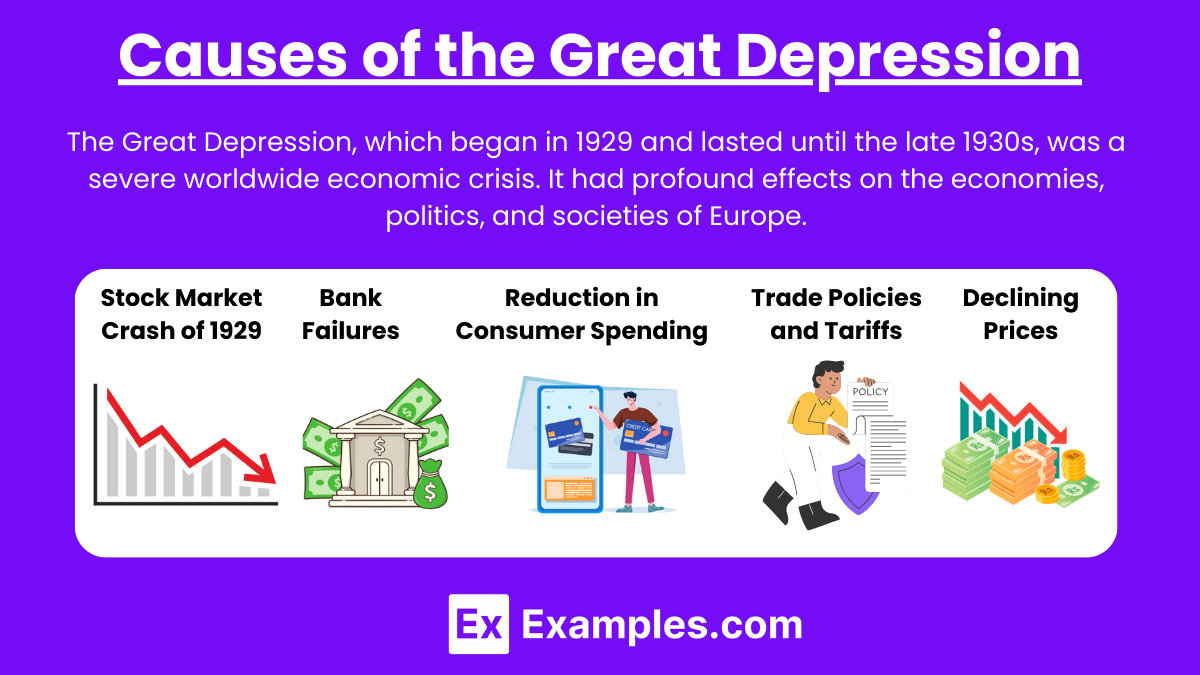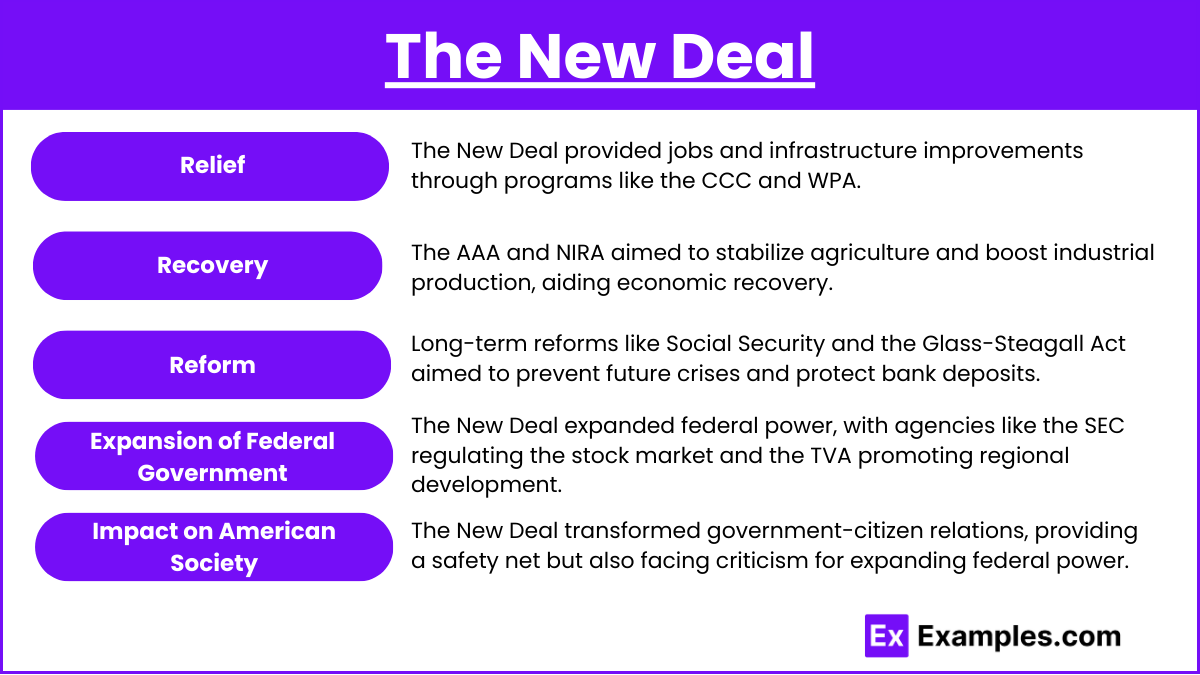In AP United States History, the Great Depression and the New Deal are studied as transformative periods in American history. The Great Depression, beginning with the stock market crash of 1929, led to widespread economic hardship, unemployment, and social upheaval. In response, President Franklin D. Roosevelt’s New Deal introduced a series of government programs and reforms aimed at providing relief, recovery, and reform. These initiatives expanded the role of the federal government and left a lasting impact on American society and the economy.
Learning Objectives
The learning objectives for the topic “The Great Depression and the New Deal” will include the ability to analyze the causes and effects of the Great Depression, including its impact on American society and the global economy. You will be expected to evaluate the New Deal programs and reforms implemented by Franklin D. Roosevelt, assessing their effectiveness in providing relief, recovery, and reform. Additionally, you will be required to understand the long-term impact of the New Deal on the role of the federal government.
Causes of the Great Depression

- Stock Market Crash of 1929:
- The crash, known as “Black Tuesday,” occurred on October 29, 1929, leading to a rapid decline in stock prices and the loss of billions of dollars in wealth. This event is often seen as the immediate trigger of the Great Depression.
- Bank Failures:
- As banks failed, people lost their savings, and the banking system collapsed, leading to a severe contraction in the money supply. Bank failures were partly caused by risky lending practices and the lack of federal insurance for deposits.
- Overproduction and Under consumption:
- Industries and farms produced more goods than the market could absorb, leading to falling prices and unsold inventories. The disparity between production and consumer purchasing power exacerbated the economic downturn.
- Decline in International Trade:
- High tariffs, like the Smoot-Hawley Tariff of 1930, reduced international trade, hurting U.S. exports and worsening the global economic situation. The global economic decline also impacted the U.S. economy.
- Dust Bowl:
- Severe droughts in the Great Plains, combined with poor farming practices, led to the Dust Bowl, displacing thousands of farmers and compounding the economic misery in rural America.
The New Deal

- Relief:
- The New Deal provided immediate relief to those suffering from the effects of the Depression through programs like the Civilian Conservation Corps (CCC) and the Works Progress Administration (WPA), which created jobs and improved infrastructure.
- Recovery:
- Programs aimed at economic recovery included the Agricultural Adjustment Act (AAA), which sought to stabilize agricultural prices by paying farmers to reduce production, and the National Industrial Recovery Act (NIRA), which aimed to boost industrial production and improve labor conditions.
- Reform:
- Long-term reforms were implemented to prevent future economic crises. The Social Security Act established a system of unemployment insurance and old-age pensions. The Glass-Steagall Act reformed the banking industry by separating commercial and investment banking and creating the Federal Deposit Insurance Corporation (FDIC) to insure bank deposits.
- Expansion of Federal Government:
- The New Deal significantly expanded the role of the federal government in the economy. Agencies like the Securities and Exchange Commission (SEC) were established to regulate the stock market, and the Tennessee Valley Authority (TVA) provided regional development and electrification.
- Impact on American Society:
- The New Deal reshaped American society by providing a safety net for the vulnerable and transforming the relationship between the government and its citizens. It also faced criticism from both the left and right, with some arguing that it did not go far enough and others believing it expanded government power too much.
Examples
- Social Security Act (1935): Established a system of old-age pensions, unemployment insurance, and aid to the disabled and families with dependent children.
- Works Progress Administration (WPA): Employed millions of Americans in public works projects, including building roads, schools, and parks.
- Tennessee Valley Authority (TVA): A regional development program that provided electrification, flood control, and economic development in the Tennessee Valley.
- Civilian Conservation Corps (CCC): Created jobs for young men in conservation projects, such as planting trees and building infrastructure in national parks.
- Glass-Steagall Act (1933): Reformed the banking industry by separating commercial and investment banking and establishing the FDIC to protect bank deposits.
MCQs
- What was a primary goal of the New Deal?
- A) To promote laissez-faire economic policies
- B) To provide relief, recovery, and reform to the American economy
- C) To reduce the size of the federal government
- D) To increase U.S. involvement in foreign wars
Answer: B) To provide relief, recovery, and reform to the American economy
Explanation: The New Deal aimed to address the economic crisis of the Great Depression through programs that provided immediate relief, promoted economic recovery, and implemented long-term reforms.
- Which New Deal program was created to provide jobs through public works projects?
- A) Social Security Act
- B) Tennessee Valley Authority
- C) Works Progress Administration
- D) Federal Deposit Insurance Corporation
Answer: C) Works Progress Administration
Explanation: The Works Progress Administration (WPA) provided jobs for millions of Americans by funding public works projects, including the construction of roads, schools, and parks.
- What was the purpose of the Glass-Steagall Act?
- A) To promote agricultural production
- B) To regulate the stock market
- C) To separate commercial and investment banking and protect bank deposits
- D) To provide unemployment insurance
Answer: C) To separate commercial and investment banking and protect bank deposits
Explanation: The Glass-Steagall Act reformed the banking industry by separating commercial and investment banking and creating the FDIC to insure bank deposits, helping to restore public confidence in the financial system.


